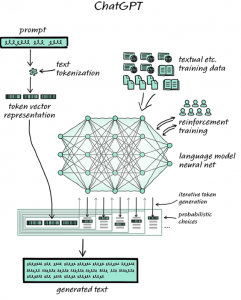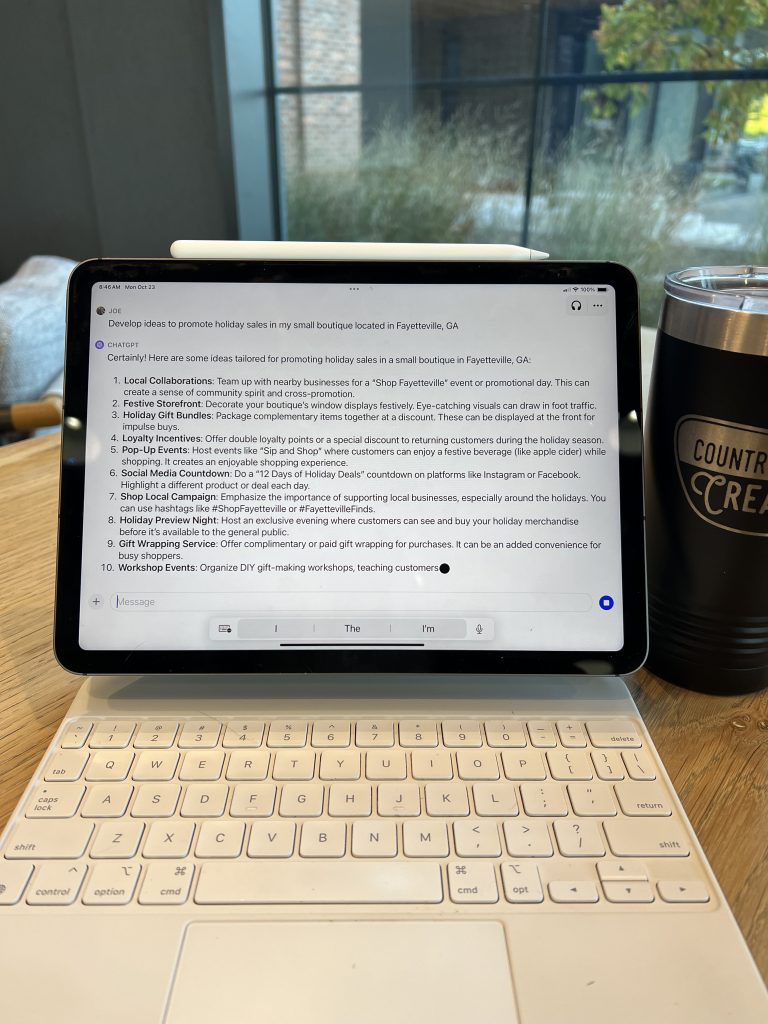by Joe Domaleski | Oct 30, 2023 | Blog, Business, Columnists, Community, Front Page, News Center, Opinion
It seems a bit ironic that I would write a column about handling stress, especially when I grapple with it myself. Over the years, running a small marketing agency has taught me that the holiday season, while filled with festive cheer and holiday excitement, can also bring its own set of challenges. Balancing client demands, ensuring the team is in high spirits, and dealing with the personal pressures the season sometimes brings, has been a learning journey. Recently, I found myself confronting the “double whammy” of two particularly stressful situations that, admittedly, got the better of me.
In the first situation, a long-time client lied to me. Because I tend to be a trusting person, I couldn’t see the situation for what it was and had to get an outside perspective. “Yes Joe, they lied to you and they did so probably because they didn’t have the heart to handle the situation with you directly,” said my trusted advisor. I kept playing back the situation in my head thinking I had done something wrong or was misreading something. What made the situation more awkward was the fact that some others in the community that I trusted, played along with the deception. Instead of just letting it go, I held on to the situation and stewed over it in my head.
During the same time frame, I had to handle the dismissal of an under-performing team member. We have great employees and in our twenty year history have rarely had to let anyone go. It’s in my nature to seek the best in others, which sometimes blinds me to reality. In this case, we had to make a change after multiple attempts to make things better. Terminating someone’s employment is always a stressful and disheartening task.
Specific sources of stress we face as a small marketing agency include:
- High Client Expectations: Although we pride ourselves on high quality creative services, some clients have expectations that rival those for larger agencies who are operating with bigger budgets.
- Tight Deadlines: I don’t think this is unique to our industry or firm – society is impatient. While quality takes time, most people don’t want to wait which puts pressure on deadlines. We tend to move much quicker than industry averages but that can sometimes create unrealistic expectations.
- Diverse Skill Demands: Even though we’re larger than many other local marketing firms, we’re still a small company. Our employees often wear multiple hats, which can be both rewarding and stressful, especially if they’re stepping into unfamiliar territory. We try really hard to keep business local with local employees – which bucks the trend of outsourcing things overseas.
- Client Dependency: We love all of our clients – large and small. Relying heavily on a few clients for revenue is stressful, as losing just one client can have a significant financial impact. For those of you running organizations with large contracts or grants, you know exactly what I’m talking about.
- Financial Pressures: Managing budgets, ensuring positive cash flow, and dealing with the uncertainties of fluctuating income can be a source of ongoing stress. Probably the biggest challenge facing our business is accounts receivable. The business is coming in, but getting paid for our work is sometimes a challenge.
- Keeping Up with Trends: The fast-paced nature of marketing, with ever-evolving digital platforms and consumer behaviors, means we must continually adapt and learn.
- Scaling Challenges: We’ve struggled with this as do most businesses that are growing. Hiring the right talent, expanding our client base, and remaining true to our hometown base is not easy.
- Client Communication: Again, not unique to my company but managing client expectations, handling feedback, or dealing with difficult clients can be challenging and stressful.
- Dealing with Rejection: Rejection is an inherent part of our industry. Whether it’s a pitch that didn’t win a client over, a campaign idea that was turned down, or a proposal that didn’t secure funding, rejection is disheartening and it’s hard not to take it personally. For small agencies like mine, where every potential client and project can be crucial for growth and sustainability, these rejections can feel even more personal and impactful.

The Country Fried Creative team enjoys a class at Sweet Tea Yoga in Peachtree City. Instructor Tanya Dunne leads the class. Photo/Joe Domaleski
In preparation for the forthcoming holiday season, we dedicated our October company-wide meeting to health, wellness, and specifically, stress management. We conducted our session at Sweet Tea Yoga in Peachtree City. Guided by the expertise of instructor Tanya Dunne, our team engaged in a unique class tailored to enhance our well-being. Although I’ve attended similar Yoga classes myself, this is the first time I’ve participated in one with my co-workers. I highly recommend the shared experience as it shows team commitment to wellness.
Every business, indeed, every person has to contend with stress especially during the holiday season. Last year, I wrote an article entitled, “It’s always darkest before the dawn”, which identified some typical sources of holiday stress along with some general guidance on how to handle them. All of that guidance is still applicable, but for this article I want to focus specifically on keeping calm by letting things go.
In trying to deal with the stressful situations I mentioned above, I came to the realization that I was holding on to negative emotions too long. This self-awareness led me to the Parable of the Glass of Water, which illustrates the importance of letting go of life’s stresses and worries.

Holding a glass of water. Photo/Imago Photo – stock.adobe.com
In the story, a professor holds up a glass of water and asks her students how heavy they think it is. The answers vary, but the professor explains that the absolute weight doesn’t matter. What matters is how long one holds onto it. Holding it for a minute is manageable, but holding it for hours will cause strain and pain, and holding it for days will paralyze one’s arm. The same goes for our stresses and worries. Think of them as the glass of water. Hold onto them for a bit, and they’re bearable. But if we carry them all day, they become burdensome, and holding onto them longer can weigh us down completely. The lesson is to let go of the stresses and not carry them for extended periods.
As leaders, we are often told to be strong pillars for our team, to exude confidence and surety in every decision, and to always be the guiding beacon. Yet, it’s essential to recognize that we too are human, susceptible to the same stresses and strains as everyone else. The Parable of the Glass of Water is a gentle reminder that while challenges and setbacks are inevitable, how we choose to handle them determines their impact on our well-being and those around us. By learning to release these burdens promptly, we not only preserve our mental and emotional health but also foster a nurturing environment where our team feels supported and understood.
As we approach the holiday season, remember to keep calm, let go, and carry on. We got this!
[Joe Domaleski, a Fayette County resident for 25 years, is the owner of Country Fried Creative – an award-winning digital marketing agency located in Peachtree City. His company was the Fayette Chamber’s 2021 Small Business of the Year. Joe is a husband, father of three grown children, and proud Army veteran. He has an MBA from Georgia State University and enjoys sharing his perspectives drawing from thirty years of business leadership experience. Sign up for the Country Fried Creative newsletter to get marketing and business articles directly in your inbox. ]
by Joe Domaleski | Oct 23, 2023 | Blog, Business, Columnists, Community, News Center, Opinion
Yes, I use Artificial Intelligence (AI) to help manage my small business and I think it’s something you should consider as well. During my time in the Army, we used the term “force multiplier” to describe any technology or strategy that amplifies the effectiveness of a combat force beyond just the sheer number of troops. Essentially, a force multiplier enables a group to accomplish more than they could on their own. It’s about gaining an edge, be it in efficiency, capability, or effectiveness. For me, AI has become that force multiplier in my small business.

How ChatGPT works – Stephen Wolfram (2023), “Wolfram|Alpha as the Way to Bring Computational Knowledge Superpowers to ChatGPT,” Stephen Wolfram Writings.
So, what exactly is AI? At its core, AI is the ability of a machine to mimic intelligent human behavior. Previously restricted to laboratories, research centers, and mega-corporations, AI has become widely accessible, even on desktop computers. It covers a vast spectrum, from robotics and computer vision to natural language processing (NLP). The primary objective of AI is to develop systems capable of tasks that generally need human intelligence, like pattern recognition, decision-making, and language understanding.
My own history with AI goes back to the 90’s when I was in graduate school studying business at Georgia State University. Putting my math and computer science degree to work, I wrote code in a programming language called “C” to do financial forecasting using algorithms based on back-propagation neural networks. This code utilized mathematical concepts like the chain rule from calculus, Mean Squared Error (MSE) from statistics, eigenvectors from linear algebra, and data representation from matrices. Fast-forward to 2023, and sophisticated tasks can now be done online without deep mathematical insights (though, at its core, AI still relies on math and linguistic representation).
One of the standout applications for desktop AI is ChatGPT, rooted in OpenAI’s GPT (Generative Pre-trained Transformer) framework. It operates based on three primary characteristics:
Generative: Enables text creation, ideal for language modeling, dialogue, and content production.
Pre-trained: The model is first trained on extensive text data for a foundational understanding of language before being fine-tuned for specific tasks.
Transformer: This neural network structure, used by GPT, excels at grasping data sequences, like word arrangements in sentences.
Given these traits, AI (especially ChatGPT) proves significantly more insightful than a mere Google search. Upon receiving a user prompt, ChatGPT formulates a response grounded in its training, striving for relevant and coherent answers. My older readers might remember diagramming sentences in English class. Well, AI kind of works like that with massive amounts of data.
Now that we’ve covered AI’s basics, my personal history with it, and its operational mode, let’s explore some examples of its use. Here are some ways I’ve used AI to help me and my clients:
- Research – “What are the latest trends in sustainable packaging for retail?”
- Idea generation – “Unique promotional ideas for my restaurant, please?”
- Proofreading – “Can you review and proofread the following article?” (NOTE: I use this all of the time)
- Education – “I want to train my staff about customer service. Can you provide a brief on handling difficult customers?”
- Entertainment – “We’re hosting a trivia night at our bookstore. Can you give me some literature-themed questions?”
- Simulations – “I’m thinking of changing my restaurant layout. Can you simulate customer flow for a seating arrangement of 10 tables near the counter and 5 near the window?”
- Problem-solving – “My bakery’s sales have dropped in the last month. Any ideas on potential causes or solutions?”
- Code generation – “I need a simple code to add a newsletter sign-up form on my website.”
- Data analysis – “I have sales data from the last 6 months. Can you help me identify any patterns or trends?”
- Decision making – “I’m torn between extending my store hours or opening a second location. What are some factors to consider?”
- Optimization – “How can I optimize the inventory turnover for my clothing boutique?”
- Automation – “I spend too much time on invoicing. Any automation suggestions?”

The author uses ChatGPT4 on an iPad to generate business ideas. Photo/Joe Domaleski
The examples above are called “prompts.” Prompts are essential when communicating with AI like ChatGPT, as they guide the model’s responses. Crafting effective prompts can help you get more precise and relevant answers. Here are some tips on using AI prompts:
Clarity: It’s crucial to be clear about what you’re asking. Unclear or vague prompts can lead to ambiguous or irrelevant responses.
Context: To get a relevant response, it’s helpful to provide the context or setting within the prompt so that answers are pertinent.
Iterative: The process of asking (prompting), receiving an answer, and then refining or redirecting based on the response can lead to better results.
Direction: Providing direction in your prompts helps narrow down the response to align with expectations. You can guide the type, depth, or style of the answer you’re seeking.
While AI’s potential and user-friendliness are evident, it’s crucial to acknowledge its inherent drawbacks. It cannot distinguish between truths and fallacies, lacks a memory of past interactions, and can sometimes sound overly mechanical. This is very apparent when you get AI to generate long-form written content or graphics.
In wrapping up, infusing AI into your business operations, notably tools like ChatGPT, can revolutionize how a small team functions and act as a force multiplier. Like any tool, its efficiency heavily leans on the user’s grasp of its pros and cons. To me, it’s akin to a digital assistant enhancing my decision-making and creative processes.
As we journey further into the digital age, it’s vital for entrepreneurs to embrace these advancements like AI, ensuring they remain at the cutting edge of their industries and offer the best to their customers and stakeholders.
Do you use AI in your business and, if so, how does AI fit into your business operations?
BONUS AFTERWORD
I asked ChatGPT 4.0 to review this article prior to publication. Here’s what it had to say:
Strengths:
- Engaging Introduction: You’ve opened with a personal touch by mentioning your Army experience and the concept of “force multiplier”, effectively hooking the reader’s interest.
- Clear Explanation of AI: The article offers a lucid overview of AI, catering both to novices and those with a foundational understanding.
- Personal Touch: Integrating your history with AI adds depth, making the article relatable and establishing your credibility.
- Relevance of ChatGPT: Highlighting ChatGPT showcases a modern, accessible application of AI that many businesses might find immediately useful.
- Practical Examples: Listing the ways you’ve used AI in real-world scenarios provides readers with tangible ideas for integrating AI into their own businesses.
- Tips on Using AI: The section on crafting effective prompts is a valuable guide, particularly for those unfamiliar with how AI models like ChatGPT operate.
- Balanced Perspective: You’ve presented not only the benefits but also the limitations of AI, ensuring readers have a comprehensive understanding.
Areas for Improvement:
- Elaborate on Drawbacks: While you’ve mentioned some of the limitations of AI, it might be beneficial to go into slightly more detail, especially regarding long-form content generation and the potential pitfalls there.
- Case Studies: Consider adding a case study or two to illustrate how AI has benefited a specific aspect of a business. This can give readers a clearer picture of its real-world impact.
- Conclusion: The wrap-up effectively reiterates the importance of AI in today’s business world. However, ending with a question is a great way to encourage engagement and comments, but perhaps you could also provide an avenue for readers to share their experiences, like a forum or comment section.
- Formatting: Consider using subheadings, bullet points, or infographics to break up longer sections, enhancing readability.
- External References: To boost credibility, consider linking to external sources or studies that validate the benefits and applications of AI in small businesses.
Overall:
The blog post is informative, relatable, and offers a balanced perspective on the application of AI in small businesses. It merges personal anecdotes with general advice, making it engaging for readers from various backgrounds. With a few minor enhancements, it could be an excellent resource for small business owners looking to integrate AI into their operations.
[Joe Domaleski, a Fayette County resident for 25 years, is the owner of Country Fried Creative – an award-winning digital marketing agency located in Peachtree City. His company was the Fayette Chamber’s 2021 Small Business of the Year. Joe is a husband, father of three grown children, and proud Army veteran. He has an MBA from Georgia State University and enjoys sharing his perspectives drawing from thirty years of business leadership experience. Sign up for the Country Fried Creative newsletter to get marketing and business articles directly in your inbox. ]
by Joe Domaleski | Oct 16, 2023 | Blog, Business, Columnists, Community, News Center, Opinion
Ah, Halloween. The time of year when the air turns crisp, the days grow shorter, and shadows play tricks on our eyes. Just as children brave haunted houses and spooky trails for the thrill and candy, many of us small business owners navigate our own labyrinth of challenges and fears in the entrepreneurial realm. Let’s have some fun with the Halloween theme and explore the spine-chilling aspects of being a small business owner and how to fend off those fearsome foes.
The Phantom of Financial Uncertainty – Just as fog can cloud our vision on a dark, eerie night, the murky waters of financial uncertainty can be a daunting specter for any business owner. Staying prepared with an emergency fund, diversified income streams, and a watchful eye on the market can light the way.
The Zombies of Competition – Bigger businesses can seem like relentless zombies, ever-advancing and hard to fend off. But remember, agility, creativity, and personal touch are your silver bullets. Stay adaptable and offer what the big guys can’t.
The Chains of Work-Life Imbalance – Being haunted by constant calls, emails, and responsibilities can wear you down. Schedule downtime and maintain boundaries to keep those ghosts at bay.
The Witch’s Brew of Decision-making – Every choice can seem like an ingredient in a mysterious potion. Take the time to research, consult, and reflect before adding anything to your cauldron.
The Goblins of Government Regulations – These mischievous creatures can pop up when least expected. Regularly check in with regulatory bodies, join business associations, and consider legal counsel to stay informed.
The Werewolf of Employee Woes – Employees can be both a blessing and a challenge. Proper training, open communication, and team-building can help keep the werewolf in human form.
The Vampire Clients – Relying too much on a few key clients can drain the life out of your business. Diversify your clientele, and always be on the lookout for new opportunities.
The Technological Poltergeist – Tech can be both a tool and a trickster. Regular updates, training, and sometimes even an exorcist (read: technology specialist) can keep things running smoothly.

Our company’s Web Manager Hollie Holder in the Halloween spirit as she talks about web project management to our team. Photo/Joe Domaleski
The Ghostly Absence – Being the heart and soul of your business, your sudden absence can haunt operations. Have a plan in place so the spirit of your business lives on, even if you need a break.
Economic Witches’ Spells – Market fluctuations can seem like spells cast to thwart your success. Stay informed, flexible, and have a backup plan to weather any storm.
The Shape-shifting Customer – Just like legendary creatures that change form, customer behaviors evolve. Stay attuned to their needs, preferences, and feedback to adapt accordingly.
The Dark Shadow of Failure – The fear of failure can follow you like a dark shadow. Embrace it, learn from missteps, and remember that every sunrise dispels darkness.
Navigating the entrepreneurial landscape can sometimes feel like wandering through a maze of haunted woods, full of unexpected twists and turns. But remember, even the eeriest tales have heroes who, with courage and determination, overcome their fears to find their way. As business owners, we learn, adapt, and grow stronger with each challenge, turning every spooky setback into a stepping stone towards success. So this Halloween, as you embrace the thrill of the unknown, let it remind you of the incredible journey of entrepreneurship and the magic that lies in perseverance. Happy Haunting and Happy Hustling! 🎃🌙🦉
[Joe Domaleski, a Fayette County resident for 25 years, is the owner of Country Fried Creative – an award-winning digital marketing agency located in Peachtree City. His company was the Fayette Chamber’s 2021 Small Business of the Year. Joe is a husband, father of three grown children, and proud Army veteran. He has an MBA from Georgia State University and enjoys sharing his perspectives drawing from thirty years of business leadership experience. ]
by Joe Domaleski | Oct 9, 2023 | Blog, Business, Columnists, Community, Front Page, News Center, Opinion
Last Saturday night, I had the pleasure of joining the Flint River Astronomy Club at Lake Horton for ‘A Night Under the Stars,’ sponsored by Fayette County Parks and Recreation. It was a beautiful fall evening, with clear skies showcasing a dazzling array of stars, planets, and galaxies. I was fascinated to see how each amateur astronomer utilized various telescopes and devices to observe the night sky with clarity. They not only set up viewing devices for the public but also shared insights using each other’s equipment. The club engages in public outreach and also serves as a platform for members to learn from one another. One astronomer shared that achieving a clear and complete view of the night sky involves numerous tools and techniques. Being a science nerd myself, I thought astronomy might serve as a fun backdrop to explore the topic of clarity.

A Night Under the Stars from 2022 at Lake Horton. Photo/Joe Domaleski
Astronomy is a celestial science that urges us to gaze upwards and outwards, exploring the universe’s vast, complex systems. Just like astronomers use various tools and work together to explore the starry skies above, business leaders also journey through their own world. The careful watching, ongoing learning, and teamwork shown by the star-gazers can be a helpful picture for business owners and leaders looking to understand their own business world better. They seek clarity amidst a myriad of stars, planets, and galaxies – each symbolizing different facets of their enterprise. Drawing parallels from the cosmos, let’s consider ways that leaders can attain a deeper, richer understanding of their business and the world in which it operates.
Embrace the Cosmic Perspective
- Vastness and Detail: Much like our universe, businesses consist of varied, interconnected elements. Just as astronomers understand both the tiny details of individual celestial bodies and the broader cosmic structures, business leaders must balance a focus on detailed operations with overarching strategic views, recognizing the interplay of diverse business aspects and scale.
- Continuous Exploration: The universe constantly unfolds new mysteries and realms. Similarly, leaders should maintain a stance of continual exploration and learning, ensuring they’re attuned to emerging trends, technologies, and opportunities in their business landscape.
Navigate by the North Star
- Vision as Your Guiding Light: Astronomers use the North Star (Polaris) to navigate the celestial sphere. In like manner, your business vision should serve as a steadfast guide, ensuring every decision and strategy aligns with your ultimate objectives.
- Consistency in Leadership: Much like the consistency of Polaris, maintain a steady, reliable leadership style that guides your team, even amidst the evolving business cosmos.
Understand Your Galactic Cluster
- Interconnected Realms: Our galaxy, among countless others, forms a bound network in the vast universe. Your business, too, exists within a network of markets, industries, and global events. Comprehending these interconnections assists leaders in anticipating shifts and navigating through various external influences.
- Harmony in Diversity: The universe thrives in its diverse, expansive nature. Cherish the diversity within your team, leveraging varied skills and perspectives to foster innovation and resolve challenges creatively.
The Black Holes: Hidden Dangers
- Avoiding Gravitational Pull: Black holes absorb everything that ventures too close. Similarly, leaders must be wary of potential pitfalls that could detract from their path, such as unfavorable deals, toxic business relationships, or unproductive ventures.
- Innovative Escapes: Sometimes, innovative strategies and bold decisions, much like the jets propelling from black holes, can propel your business out of stagnancy and into vibrant, new territories.
Adapt to Cosmic Shifts
- The Expanding Universe: Just as the universe continuously expands and evolves, the business world is in perpetual flux. Adapting to changes, be it technological advancements, market dynamics, or internal developments, is vital to sustainable success.
- Sustainable Transformations: Implement changes that not only address immediate concerns but are also sustainable in the long run, ensuring your business remains resilient amidst future cosmic shifts.
As I was writing this piece, the subject of clarity and clear skies reminded me of this song:
I can see clearly now the rain is gone
I can see all obstacles in my way
Gone are the dark clouds that had me blind
It’s gonna be a bright (bright)
Bright (bright) sunshiny day
– “I Can See Clearly Now” by Johnny nash
Embracing and understanding the vast, interconnected, and inherently mysterious universe of your business, while nimbly adapting to its dynamic nature, lays the foundation for astute and enlightened leadership. As you embark on this starry adventure with your business, may you find abundant opportunities for success, navigate through challenges, and propel your projects into a future that is not only financially prosperous but also vibrant and robust. Here’s to exploring the cosmos of your business with clarity, curiosity, and courage, guiding your team to stellar heights and beyond!
[Joe Domaleski, a Fayette County resident for 25 years, is the owner of Country Fried Creative – an award-winning digital marketing agency located in Peachtree City. His company was the Fayette Chamber’s 2021 Small Business of the Year. Joe is a husband, father of three grown children, and proud Army veteran. He has an MBA from Georgia State University and enjoys sharing his perspectives drawing from thirty years of business leadership experience. ]
by Joe Domaleski | Oct 2, 2023 | Blog, Business, Columnists, Community, Front Page, News Center, Opinion
Rejection is part of life. This past week, I experienced rejection both personally and professionally. Both were isolated incidents, but both situations hurt. Having one’s ideas rejected is difficult and it’s hard not to take that personally. For leaders, each “no” can feel like a roadblock to success. I spent the weekend thinking about rejection to find the upside. Time and reflection do make things better. I realized that with the right mindset, these rejections can become the fuel that propels me and my business to new heights.
Let’s take a look at some common types of rejection and provide some insights on how to handle and learn from them. Here are some common ways people might experience rejection:
- Personal relationships – not having feelings reciprocated from friends, families, and romantic relationships. This is especially true if you’re a “Words of Affirmation” person – look that up, if you don’t know what that means.
- Professional relationships – being passed over for a job offer, promotion, loan application, or acceptance into a professional group.
- Creative endeavors – having creative works rejected by clients or peers.
- Sales – when a prospective new customer chooses not to buy from you.
- Customer relationships – when an existing customer chooses to cancel or not renew a contract.
- Athletic performances – when you lose the game or fail to meet a specific athletic standard.
- Auditions or try-outs – not being selected for a part on a team, play, musical, or other group.
- Social settings – not being included in social groups aka “being left out”.
- Competitions and contests – not winning or advancing in a competitive scenario. This is especially frustrating if you don’t know you’re even in competition until you find out later you were!
Rejection can come in many forms and from various avenues. Here are some ways in which someone might experience rejection:
- Direct Verbal Rejection: Individuals can be straightforward and tell you ‘no’ or express their disinterest directly. This is my preferred way of getting rejected because it’s normally quick and direct. There’s no second-guessing and you can immediately move on.
- Indirect Verbal Rejection: This can be less straightforward, where someone may give vague or non-committal responses which essentially amount to a rejection.
- Non-verbal Rejection: Sometimes people show their disinterest or rejection through body language, like avoiding eye contact or turning away.
- Written Rejection: Rejection can come in the form of a letter, email, or text message, such as a declined job application or a breakup message. Similar to a direct verbal rejection, it’s very direct.
- Online Rejection: Individuals can experience rejection on social media or other online channels through unresponsiveness, unfollows, or even negative comments.
- Passive Rejection: This form of rejection happens when someone ignores your calls, messages, or invitations, essentially rejecting you without a direct confrontation. This is my least favorite form of rejection. See my earlier article about ghosting in the workplace.
- Exclusion: Similar to a passive rejection, this is specifically being left out of gatherings, meetings, or social events. It may or may not be intentional.
- Disapproval: One can also experience rejection through disapproval of their ideas, behaviors, or lifestyles. Although not as straightforward as a direct verbal or written rejection, the intent is usually pretty clear.
- Constructive Criticism: While it’s intended to help, some individuals may interpret constructive criticism as a form of rejection. It’s not easy to take constructive feedback, but the best leaders do and learn from it.
- Comparative Rejection: Being passed over for opportunities in favor of others, whether in professional, social, or personal contexts. This is normally less painful if it’s clear that you’re in competition for something. Comparative rejection when you don’t know you’re in competition is more awkward and frustrating.
Yes, you can see I did a lot of thinking about rejection over the weekend. If you’re dealing with rejection, I know how you might be feel. Each of these types of rejection can be challenging to deal with. However, as I wrote this article it helped me gain perspective. Understanding the nature of rejection and developing coping strategies can lead to personal growth and improved resilience.
Now that we’ve identified some of the situations and ways in which someone might experience rejection. Let’s examine some ways we can handle rejection.
Allow Yourself to Feel the Emotions: It’s natural to feel disappointed or upset after a rejection. Give yourself some time to process your emotions. I did that myself this past weekend.
Avoid Personalizing the Rejection: It’s important to remember that rejection is a part of life and does not define your worth. Try to separate your self-worth from the situation at hand.
Practice Self-compassion: Treat yourself with kindness, patience, and understanding. This isn’t easy to do and I tend to be harder on myself than anyone else. Self-compassion can help you recover and move forward.
Seek Support: Talk to supportive friends, family, or co-workers who can provide a positive perspective.
Learn and Grow: Reflect on the experience and see if there’s anything you can learn from it. Every rejection can be a learning experience to improve and grow.
Keep Trying: Don’t let rejection hold you back. Keep putting yourself out there and pursuing what you desire. Keep networking, improving your skills, and applying for new opportunities.
Maintain Professionalism: No matter the circumstance, it’s essential to remain professional. If given the opportunity, thank the person for their time and consideration.
Ask for Feedback: If appropriate, ask for feedback to understand why you were rejected. This information can be invaluable for improving and growing professionally. It’s not always easy to do, but if the other person opens up the lessons learned may make you even stronger than you would have been had you not been rejected.
Reflect on the Feedback: Take time to reflect on any feedback you receive, and see how you can apply it moving forward. Not all feedback is helpful, nor is rejection always warranted. Indeed, I’ve been in situations where something I proposed was rejected only to see that same idea championed and implemented later. Timing matters.
Develop Resilience: One of my new favor words – resilience. Resilience is a skill that can be built over time. Practice resilience by staying motivated, learning from rejection, and continuing to pursue your goals despite setbacks.

The author Joe Domaleski and his wife Mary Catherine at the Rocket Center in Huntsville, Alabama. They’re probably not thinking about rejection, but this picture does match the title of the article. Photo/Joe Domaleski
Rejection, despite its initial sting, can indeed be turned into rocket fuel propelling individuals towards personal and professional growth when met with a constructive mindset. By acknowledging the emotions tied to rejection, seeking supportive environments, and applying the lessons learned from each experience, individuals can build resilience and gain a deeper understanding of their goals and the pathways to achieve them.
Whether encountered in a personal relationship, a professional setting, or any other domain, rejection is not indicative of one’s worth but rather an opportunity for self-reflection and improvement. The metaphor of turning rejection into rocket fuel means transforming adversity into momentum. With the right perspective and proactive coping strategies, handling rejection becomes a journey of self-discovery and empowerment. By harnessing the energy from rejection, much like a rocket harnessing fuel, individuals can soar to new heights, achieving objectives that once seemed beyond reach.
Writing this article helped me put rejection into perspective and I hope it helps you as well. Keep soaring leaders!
[Joe Domaleski, a Fayette County resident for 25 years, is the owner of Country Fried Creative – an award-winning digital marketing agency located in Peachtree City. His company was the Fayette Chamber’s 2021 Small Business of the Year. Joe is a husband, father of three grown children, and proud Army veteran. He has an MBA from Georgia State University and enjoys sharing his perspectives drawing from thirty years of business leadership experience. ]







